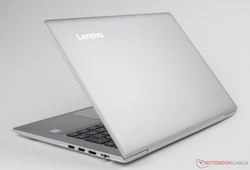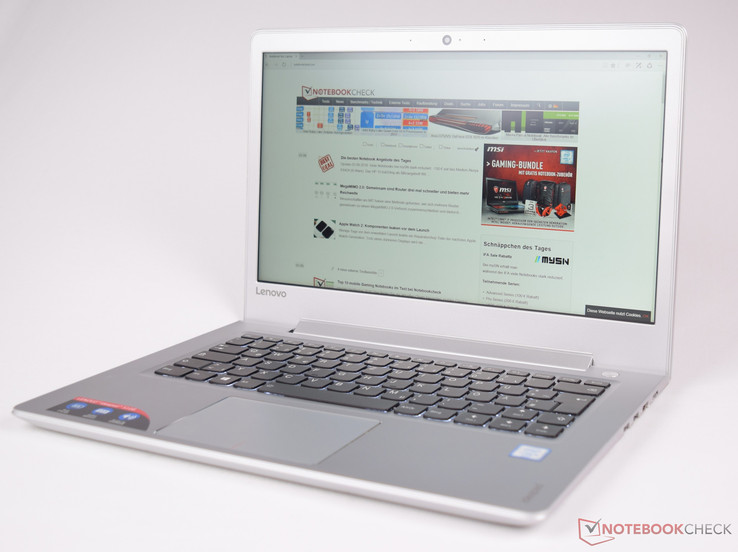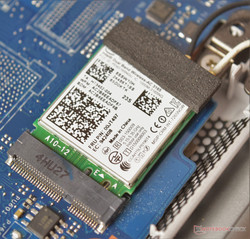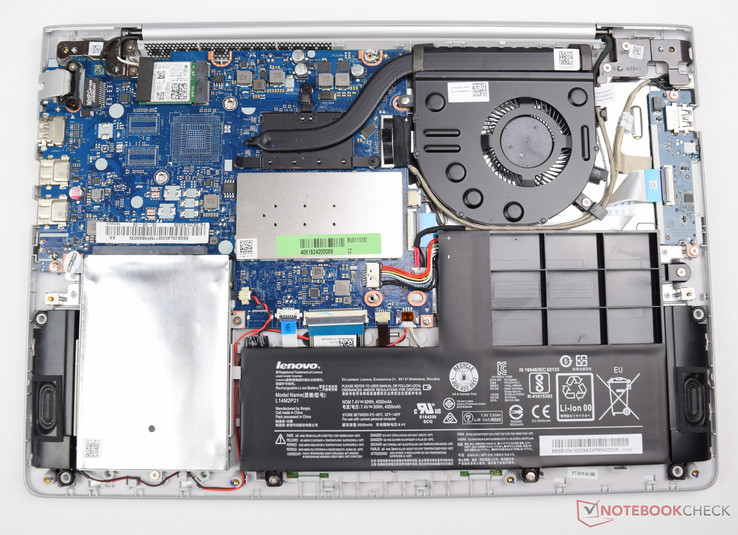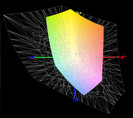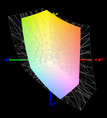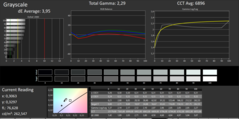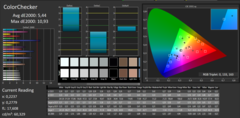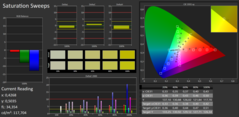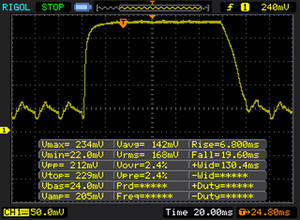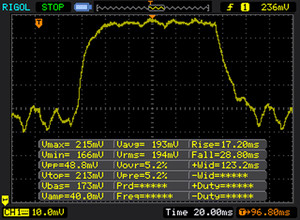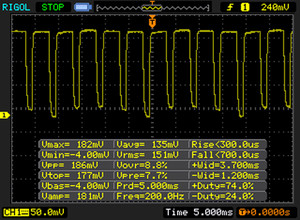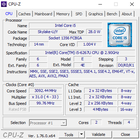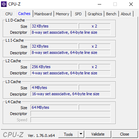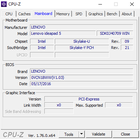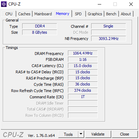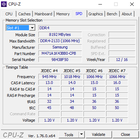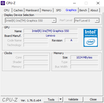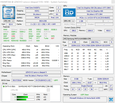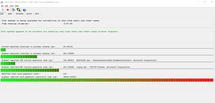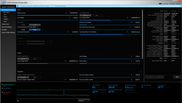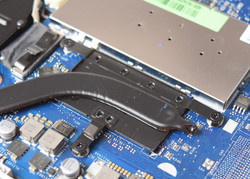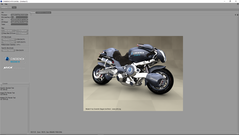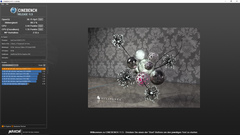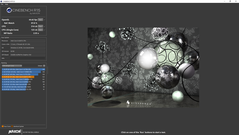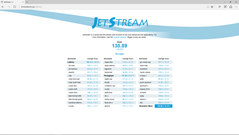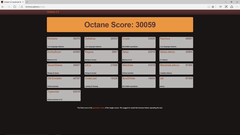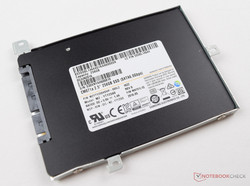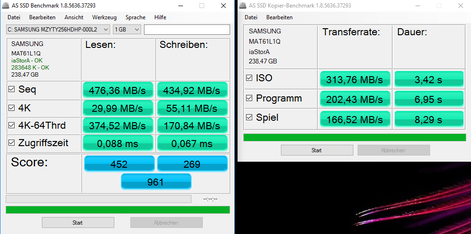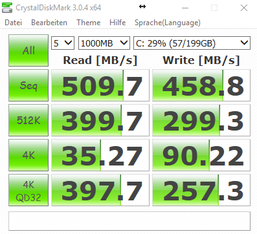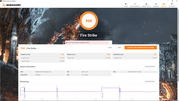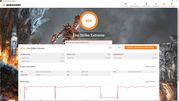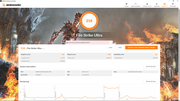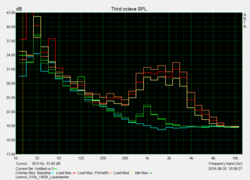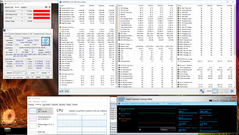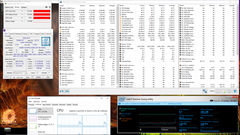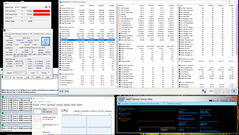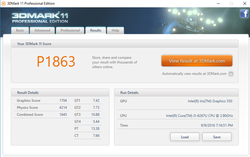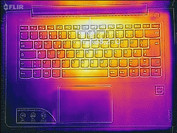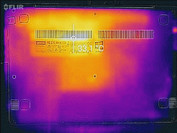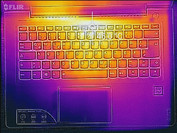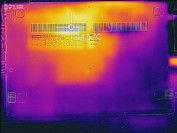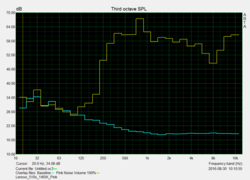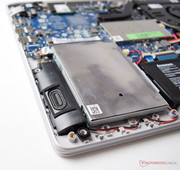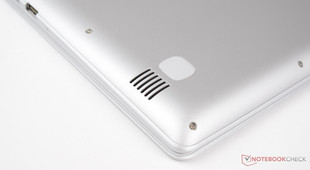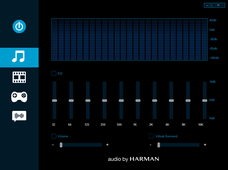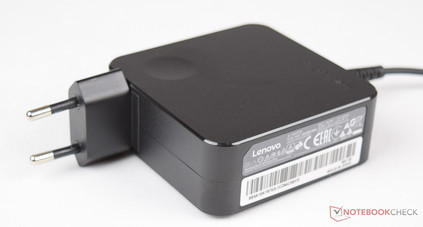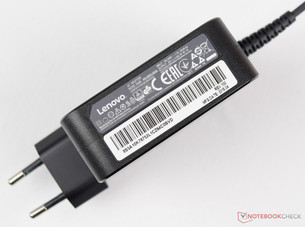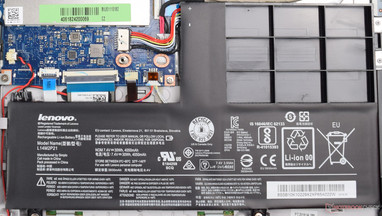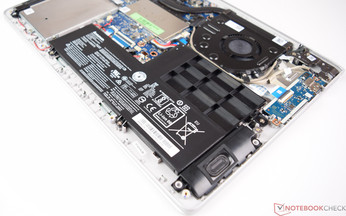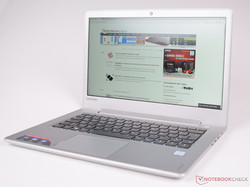Lenovo IdeaPad 510S-14ISK (80TK003KGE) Notebook Review

For the original German review, see here.
HP, Asus, and Acer have presented some attractive devices in the first half of this year. They have a good price-performance ratio in common. Lenovo, of course, does not want to simply stand aside and rocks the subnotebook market with the now released IdeaPad 510S lineup. Lenovo's IdeaPad 510S-14ISK that we have been provided with for testing purposes is a 14-inch subnotebook. Our review sample houses a sixth-generation Intel Core i5 ULV processor. The newest devices that will soon be launched will even be furnished with seventh-generation Core processors. Intel's Iris Graphics 550 serves as the graphics accelerator in our case. Its performance is much better than Intel's HD Graphics 520.
However, Lenovo also offers other hardware configurations. Intel's Core i5-6200U alongside AMD's Radeon R5 M430 and a 1 TB, 2.5-inch hard drive in a slim case starts the series (799 Euros, ~$897). Another option is Intel's faster Core i7-6500U. AMD's Radeon R7 M460 dedicated GPU is installed here. The conventional hard drive makes way for a 256 GB, 2.5-inch SSD. The faster bundle is priced at 999 Euros (~$1121). Both GPU solutions also include a 2 GB dedicated VRAM and thus do not load the 8 GB DDR4 RAM that all models have in common.
Our review configuration is no longer listed on Lenovo's German website. Buyers who are happy with the performance of Intel's Core i5-6267U in conjunction with Intel's Iris Graphics 550 can purchase the device for 799 Euros (~$897) in diverse online shops.
There are plenty of devices that could be used for comparison in this test. However, we decided to set the price limit at 1000 Euros (~$1123). Thus, we selected the following devices for this test report:
- Lenovo IdeaPad 500s-14ISK (999 Euros, ~$1121)
- Asus X302UV-FN016T (699 Euros, ~$785)
- Acer Aspire V3-372-57CW (720 Euros, ~$808)
- HP Envy 13-d020ng (999 Euros, ~$1121)
- Acer Aspire V3-372 (799 Euros, ~$897)
Case
Most of the completely silver-colored casing is made of plastic and aluminum. The upper sides are metal and the undersides are plastic. Lenovo's logo adorns the casing's lid. The IdeaPad 510S-14ISK is relatively inconspicuous otherwise. The silver design makes a high-quality impression and is not overly susceptible to fingerprints. The base's build is solid and can only be warped with effort.
The display lid also makes a positive impression. Like the base, it is stiff and can only be warped with effort. Thus, the plastic and metal mix is a good choice, and the casing is equipped for everyday use.
Both hinges that keep the display in every desired position do a good job. The display only rocks to an acceptable extent and cannot be opened with one hand. The device looks very thin in a closed state. The keyboard and touchpad are incorporated directly into the base's upper side. A chrome bezel frames the touchpad. The panel has been incorporated well into the casing's lid, and the edges are relatively narrow.
Although the IdeaPad 510S-14ISK does not have a maintenance hatch, the base unit's tray can be removed easily. Caution: After releasing all screws, innumerable plastic clips that could break easily when removing the base tray heedlessly surround the plate. The RAM, SSD, battery, and small fan can be accessed after successful disassembly.
Size Comparison
The size comparison shows that the IdeaPad 510S-14ISK belongs to the largest devices in terms of surface area. However, this is due to its 14-inch size. Some comparison devices, such as HP's Envy 13-d020ng with only a 13.3-inch diagonal, naturally need a smaller platform. Lenovo's IdeaPad 510S-14ISK weighs approximately 1.5 kilograms. The weight is absolutely acceptable for this laptop size. Lenovo's casing is thinner than the rivals from Acer (19.7 millimeters) and Asus (25.6 millimeters) but is thicker than HP's laptop (12.6 millimeters).
Connectivity
The IdeaPad 510S does not have any interface innovations compared with the 500S. Thus, Lenovo still does not install a USB 3.1 or Thunderbolt 3 port. All interfaces are on the sides. We find a Kensington lock slot for securing the device against theft on the left. Furthermore, there are a line-out and microphone jack, USB port that operates in 2.0 standard, card reader, and power socket here. Lenovo does not use the rectangular ports and again installs the known round power sockets.
Two more USB ports that support USB 3.0 speeds are on the right. An HDMI port and Gbit LAN socket are situated beside it. The interface distribution is middling. Both USB 3.0 ports are cramped, which might cause problems with big USB peripherals. It does not look like problems will occur on the left. However, the angled power plug could collide with the neighboring Kensington lock slot or USB port.
SD-Card Reader
The card reader on the side supports all common formats (MMC, SD, SDHC, SDXC). We would recommend taking out the SD card to prevent damage when transporting the laptop since roughly half of it juts out.
We test the card reader's performance with our Toshiba Exceria Pro SDXC 64 GB UHS-II reference memory card. This test involves copying 250 identical JPG files from the memory card to the hard drive. The IdeaPad 510S achieves an average speed of 49.5 MB/s after three runs. This result places the IdeaPad 510S in the midfield. The former IdeaPad 500S achieved 62 MB/s, which puts it first place among the comparison devices in this test. Both Lenovos are on par in sequential read that we determine with the AS SSD tool, closely followed by HP's Envy 13-d020ng in first and second place.
| SD Card Reader | |
| average JPG Copy Test (av. of 3 runs) | |
| Lenovo Ideapad 500s-14ISK | |
| HP Envy 13-d020ng | |
| Lenovo IdeaPad 510S-14ISK | |
| Asus X302UV-FN016T | |
| Acer Aspire V3-372-57CW | |
| Acer Aspire V3-372-50LK | |
| maximum AS SSD Seq Read Test (1GB) | |
| Lenovo Ideapad 500s-14ISK | |
| Lenovo IdeaPad 510S-14ISK | |
| HP Envy 13-d020ng | |
| Asus X302UV-FN016T | |
| Acer Aspire V3-372-57CW | |
| Acer Aspire V3-372-50LK | |
Communication
Like in the predecessor, Lenovo continues to rely on a Wireless-AC 3165 by Intel as the Wi-Fi module. This module achieves a gross data transmission rate of 433 Mbit/s. We measured 268 Mbit/s in receive and 291 Mbit/s in send in our test in ideal conditions. The theoretically possible speeds are not met, but the determined rates are on a level that is more than sufficient for normal use. We did not have any problems with this network connection in the test period. Users who need faster data transmission can establish a cabled connection of up to 1000 Mbit/s. Realtek's chip functions reliably and without problems.
| Networking | |
| iperf Server (receive) TCP 1 m | |
| Dell Inspiron 15 5568 | |
| Lenovo IdeaPad 510S-14ISK | |
| iperf Client (transmit) TCP 1 m | |
| Dell Inspiron 15 5568 | |
| Lenovo IdeaPad 510S-14ISK | |
Security
Devices not made for the business sector come with only limited security features. The IdeaPad 510S only sports a Kensington lock slot and Trusted Platform Module 2.0 (TPM). Lenovo offers a 36-month McAfee LifeSafe security software license for 100 Euros (~$112) when purchasing the laptop.
Accessories
Like most other manufacturers, Lenovo is very economic with accessories. A quick-start guide and the power supply are in the box. Lenovo does not offer any proprietary accessories for the 510S lineup. Standard accessories, such as a headphone, mouse, Kensington lock, and power bank, are found on Lenovo's shop website.
Operating System
The devices are shipped with Microsoft Windows 10 Home 64-bit operating system.
Maintenance
As said in "Casing", the IdeaPad 510S lacks a dedicated maintenance hatch like its predecessor. It has been adopted 1:1. Thus, the end user can only remove the entire base tray. However, disassembly should not be attempted without the fitting tools to prevent scratches. Although this is not exactly user-friendly, it will not be absolutely necessary to open the device very often since almost no upgrade options exist.
Warranty
Lenovo's IdeaPad 510S-14ISK is sold with a 24-month manufacturer's warranty. Various online shops offer an additional warranty packages that also go beyond the 24 months for an extra charge.
Input Devices
Keyboard
We can only repeat the positive impression of the predecessor here. The chiclet keyboard does a good job. The solid base prevents the keyboard from denting. The pressure point is clearly defined and the key drop is very pleasant. Energetic typing should not cause problems. The keys that are lightly curved in the lower part also have a comfortable size. Typing is audible but in no way distracting.
The printed letters are well legible. Furthermore, the keyboard layout looks clearly arranged and not stuffed. The keyboard's subtle three-level backlight helps when typing in the dark.
Touchpad
The ClickPad continues where the keyboard's positive qualities left off. The touchpad supports multitouch and allows accurate inputting up into the lateral areas. For example, zooming pictures functions just as impeccably as moving files or folders. Both keys incorporated in the lower area have a firm, clearly defined pressure point. It is not too spongy, which prevents unintentional clicks. However, the click noises are very audible and are louder than when typing on the keyboard. A chrome bezel clearly separates the input area's borders.
Display
Our review sample is furnished with an IPS panel by BOE. The 14-inch screen has a native resolution of 1920x1080 pixels. This leads to a pixel density of 157 PPI. Lenovo does not offer any other screen options for its IdeaPad 510S series. The FHD panel in our review sample offers a good brightness (263 cd/m²) and high contrast (1071:1). These rates are typical for IPS panels. HP proves that this can be even better with its Envy 13-d020ng. The AU Optronics screen is evidently superior to the BOE panel. The rates in the chart illustrate this clearly.
Our review sample is nevertheless impressive since its good screen brightness and an illumination of 90% are decent and allow working outdoors. The anti-glare surface also contributes to this. We have to criticize the detected screen flickering at a screen brightness of 60% or lower. The homogeneous illumination that hardly leads to visible backlight bleeding has to be mentioned positively. The screen's subjective quality is good. The decent contrast (1071:1) results in a low black level (0.35 cd/m²), and thus darker sequences are not covered by a grayish haze.
| |||||||||||||||||||||||||
Brightness Distribution: 90 %
Center on Battery: 257 cd/m²
Contrast: 1071:1 (Black: 0.24 cd/m²)
ΔE ColorChecker Calman: 5.44 | ∀{0.5-29.43 Ø4.78}
ΔE Greyscale Calman: 3.95 | ∀{0.09-98 Ø5}
64% sRGB (Argyll 1.6.3 3D)
40% AdobeRGB 1998 (Argyll 1.6.3 3D)
44.3% AdobeRGB 1998 (Argyll 3D)
64.1% sRGB (Argyll 3D)
42.88% Display P3 (Argyll 3D)
Gamma: 2.29
CCT: 6896 K
| Lenovo IdeaPad 510S-14ISK NV140FHM-N41, 1920x1080, 14" | Lenovo Ideapad 500s-14ISK Chi Mei CMN14A7, 1920x1080, 14" | Asus X302UV-FN016T InfoVision M133NWN1 R3, 1366x768, 13.3" | Acer Aspire V3-372-57CW LG LP133WF2-SPL3, 1920x1080, 13.3" | HP Envy 13-d020ng AU Optronics AUO272D, 1920x1080, 13.3" | Acer Aspire V3-372-50LK LG Display LP133WF2-SPL3, 1920x1080, 13.3" | |
|---|---|---|---|---|---|---|
| Display | -5% | 13% | -9% | 47% | -9% | |
| Display P3 Coverage (%) | 42.88 | 40.74 -5% | 48.37 13% | 39.18 -9% | 63.7 49% | 39.05 -9% |
| sRGB Coverage (%) | 64.1 | 60.6 -5% | 72.6 13% | 58.6 -9% | 93 45% | 58.7 -8% |
| AdobeRGB 1998 Coverage (%) | 44.3 | 42.15 -5% | 49.98 13% | 40.51 -9% | 65.1 47% | 40.35 -9% |
| Response Times | 8% | 10% | -12% | 16% | 3% | |
| Response Time Grey 50% / Grey 80% * (ms) | 45 ? | 43 ? 4% | 42 ? 7% | 41 ? 9% | 34 ? 24% | 46 ? -2% |
| Response Time Black / White * (ms) | 26 ? | 23 ? 12% | 23 ? 12% | 34.4 ? -32% | 24 ? 8% | 24 ? 8% |
| PWM Frequency (Hz) | 50 ? | 50 ? | 208 ? | |||
| Screen | -43% | -14% | -21% | 17% | -13% | |
| Brightness middle (cd/m²) | 257 | 249 -3% | 218 -15% | 247 -4% | 345 34% | 250 -3% |
| Brightness (cd/m²) | 263 | 235 -11% | 210 -20% | 239 -9% | 335 27% | 247 -6% |
| Brightness Distribution (%) | 90 | 87 -3% | 88 -2% | 81 -10% | 95 6% | 87 -3% |
| Black Level * (cd/m²) | 0.24 | 0.44 -83% | 0.5 -108% | 0.38 -58% | 0.25 -4% | 0.43 -79% |
| Contrast (:1) | 1071 | 566 -47% | 436 -59% | 650 -39% | 1380 29% | 581 -46% |
| Colorchecker dE 2000 * | 5.44 | 9.47 -74% | 3.89 28% | 5.95 -9% | 4.94 9% | 4.51 17% |
| Colorchecker dE 2000 max. * | 10.93 | 15.41 -41% | 7.11 35% | 14.2 -30% | 8.85 19% | |
| Greyscale dE 2000 * | 3.95 | 10.22 -159% | 4.9 -24% | 5.25 -33% | 5.85 -48% | 3.18 19% |
| Gamma | 2.29 96% | 2.34 94% | 2.41 91% | 2.42 91% | 2.25 98% | 2.43 91% |
| CCT | 6896 94% | 11451 57% | 7860 83% | 6736 96% | 7105 91% | 6743 96% |
| Color Space (Percent of AdobeRGB 1998) (%) | 40 | 39 -2% | 46 15% | 37.28 -7% | 60 50% | 37 -7% |
| Color Space (Percent of sRGB) (%) | 64 | 57 -11% | 73 14% | 58.37 -9% | 93 45% | 58 -9% |
| Total Average (Program / Settings) | -13% /
-29% | 3% /
-5% | -14% /
-17% | 27% /
23% | -6% /
-10% |
* ... smaller is better
The DeltaE 2000 rates are slightly higher than the target rate of 3 in delivery state. Furthermore, the screen also displays a light greenish tint. This rate improved after calibration. As always, we provide the corresponding ICC profile for downloading. The IPS panel reproduces 64% of the sRGB color space. It is only enough for a 40% coverage of the extended AdobeRGB color space, which is simply insufficient for professional purposes.
Display Response Times
| ↔ Response Time Black to White | ||
|---|---|---|
| 26 ms ... rise ↗ and fall ↘ combined | ↗ 7 ms rise | |
| ↘ 19 ms fall | ||
| The screen shows relatively slow response rates in our tests and may be too slow for gamers. In comparison, all tested devices range from 0.1 (minimum) to 240 (maximum) ms. » 61 % of all devices are better. This means that the measured response time is worse than the average of all tested devices (20.2 ms). | ||
| ↔ Response Time 50% Grey to 80% Grey | ||
| 45 ms ... rise ↗ and fall ↘ combined | ↗ 17 ms rise | |
| ↘ 28 ms fall | ||
| The screen shows slow response rates in our tests and will be unsatisfactory for gamers. In comparison, all tested devices range from 0.165 (minimum) to 636 (maximum) ms. » 76 % of all devices are better. This means that the measured response time is worse than the average of all tested devices (31.6 ms). | ||
Screen Flickering / PWM (Pulse-Width Modulation)
| Screen flickering / PWM detected | 50 Hz | ≤ 60 % brightness setting | |
The display backlight flickers at 50 Hz (worst case, e.g., utilizing PWM) Flickering detected at a brightness setting of 60 % and below. There should be no flickering or PWM above this brightness setting. The frequency of 50 Hz is very low, so the flickering may cause eyestrain and headaches after extended use. In comparison: 53 % of all tested devices do not use PWM to dim the display. If PWM was detected, an average of 8111 (minimum: 5 - maximum: 343500) Hz was measured. | |||
The IPS panel can again use the advantages of this technology in the viewing-angle test. This results in a clear reproduction of the test image from all nine viewing angles. A slight color distortion is only seen in a very flat and slanted view that is not needed in routine use.
The anti-glare surface alongside the screen's maximum brightness of 263 cd/m² ensures good legibility outdoors. However, the sun should not shine directly onto the screen. We would recommend looking for a sun-protected place for outdoor browsing.
Performance
The IdeaPad 510S' performance is decent for a subnotebook. It could be increased a few percent with the seventh Core processor generation. Nevertheless, Intel's Core i5-6267U in conjunction with the 8 GB of RAM provides enough power to cope with most routine tasks, such as Internet browsing, office applications or playing multimedia content. The 2.5-inch SSD also contributes to fast and lag-free working. The entry-level model of the IdeaPad 510S-14ISK is shipped with Intel's Core i5-6200U processor. The buyer can also optionally choose Intel's Core i7-6500U.
Processor
Intel's Core i5-6267U processor installed in our review sample is a rare companion. Intel's Core i5-6200U or Intel's Core i7-6500U is used more often. Intel's Core i5-6267U has a different integrated graphics unit than the other models. The performance of Intel's Iris Graphics 550 is roughly twice as high as the frequently installed Intel's HD Graphics 520. This also results in a higher TDP of 28 watts. The CPU is soldered to the motherboard and has two physical processing cores. The base clock of Intel's Core i5-6267U is 2.9 GHz, which can be boosted up to 3.3 GHz (1 core) and 3.1 GHz (2 cores) via Turbo.
The Cinebench scores that the IdeaPad 510S-14ISK achieves are on par with the former IdeaPad 500S-14ISK. Thus, both laptops calculate roughly at the same speed although Intel's Core i7-6500U is installed into the predecessor. Acer's Aspire V3-372-57CW that also uses Intel as its central processing unit can utilize its performance much better. Acer's Aspire V3-372-57CW reaps in an approximately 10% better score than its rivals in Cinebench R15.
| Cinebench R10 | |
| Rendering Single CPUs 64Bit | |
| Lenovo IdeaPad 510S-14ISK | |
| Rendering Multiple CPUs 64Bit | |
| Lenovo IdeaPad 510S-14ISK | |
| JetStream 1.1 - Total Score | |
| Acer Aspire V3-372-57CW | |
| Asus X302UV-FN016T | |
| HP Envy 13-d020ng | |
| Lenovo IdeaPad 510S-14ISK | |
| Octane V2 - Total Score | |
| Acer Aspire V3-372-57CW | |
| Lenovo Ideapad 500s-14ISK | |
| Lenovo IdeaPad 510S-14ISK | |
| Asus X302UV-FN016T | |
| Acer Aspire V3-372-50LK | |
| HP Envy 13-d020ng | |
| Mozilla Kraken 1.1 - Total | |
| Lenovo IdeaPad 510S-14ISK | |
| HP Envy 13-d020ng | |
| Acer Aspire V3-372-57CW | |
| Asus X302UV-FN016T | |
| Acer Aspire V3-372-50LK | |
| Lenovo Ideapad 500s-14ISK | |
* ... smaller is better
System Performance
The system's subjective performance is beyond reproach. The fast SSD ensures a very fast booting system and the device is ready to use within seconds. The processor clock of 2.9 GHz is much faster than those of most subnotebooks that are based only on Intel's Core i5-6200U (2.3 GHz). The 8 GB of working memory (DDR4) is sufficiently designed and is enough for most applications. The PCMark benchmark scores reflect this impression exactly. The IdeaPad 510S-14ISK places itself in second place behind Acer's Aspire V3-372-57CW with a difference of approximately 10%.
| PCMark 7 Score | 5340 points | |
| PCMark 8 Home Score Accelerated v2 | 3710 points | |
| PCMark 8 Creative Score Accelerated v2 | 4327 points | |
| PCMark 8 Work Score Accelerated v2 | 4579 points | |
Help | ||
Storage Device
Our review sample houses an SSD by Samsung. It has a storage capacity of 256 GB. Lenovo exclusively installs system storage devices in the 2.5-inch format into its IdeaPad 510S-14ISK devices. A second interface, not to mention an M.2 interface, does not yet exist. Of course, buyers can replace the SSD with an HDD with more storage capacity. However, Lenovo only sells the IdeaPad 510-14ISK with a 1 TB, conventional hard drive or this 256 GB SSD in its Internet shop.
We record the performance of Samsung's SSD with the tools AS SSD and CrystalDiskMark 3.0. AS SSD measured 476 MB/s (sequential read) and 435 MB/s (sequential write) from the 2.5-inch SSD. CrystalDiskMark achieved similar rates. The sequential read speed is even a fast 510 MB/s here. Seen subjectively, these test outcomes confirm the performance of the device in its whole. The SSD's potential performance is implemented well, making criticism unnecessary.
| Lenovo IdeaPad 510S-14ISK Samsung MZYTY256HDHP | Lenovo Ideapad 500s-14ISK Samsung PM871 MZYLN256HCHP | Asus X302UV-FN016T Hynix HFS128G3MND | Acer Aspire V3-372-57CW Kingston RBU-SNS8152S3256GG2 | HP Envy 13-d020ng Samsung MZRPC256HADR-000SO | Acer Aspire V3-372-50LK Toshiba HG6 THNSNJ256G8NU | |
|---|---|---|---|---|---|---|
| CrystalDiskMark 3.0 | -4% | -40% | -7% | -13% | -11% | |
| Read Seq (MB/s) | 510 | 507 -1% | 428.2 -16% | 515 1% | 478.7 -6% | 522 2% |
| Write Seq (MB/s) | 458.8 | 309.5 -33% | 178.6 -61% | 338 -26% | 268.5 -41% | 447.4 -2% |
| Read 512 (MB/s) | 399.7 | 409.5 2% | 282.6 -29% | 368.1 -8% | 386.6 -3% | 392.3 -2% |
| Write 512 (MB/s) | 299.3 | 308.3 3% | 179.1 -40% | 338.6 13% | 268.8 -10% | 388 30% |
| Read 4k (MB/s) | 35.27 | 36.24 3% | 6.559 -81% | 28.88 -18% | 26.88 -24% | 21.1 -40% |
| Write 4k (MB/s) | 90.2 | 93.3 3% | 71.2 -21% | 74.2 -18% | 78.7 -13% | 71.1 -21% |
| Read 4k QD32 (MB/s) | 397.7 | 394.5 -1% | 253 -36% | 319.9 -20% | 369.4 -7% | 248 -38% |
| Write 4k QD32 (MB/s) | 257.3 | 241.6 -6% | 174 -32% | 309.4 20% | 259.7 1% | 212.9 -17% |
Graphics Card
As often mentioned, a somewhat unusual CPU has been installed into this device. The CPU-integrated graphics unit of Intel's Core i5-6267U is called Intel's Iris Graphics 550. The GT3e level of the Skylake processors has a dedicated, 64 MB eDRAM cache. The Iris Graphics 550 can also access the working memory via the CPU's interface. Thus, the exact performance depends on the integrated graphics solution of each CPU and the underlying working memory (DDR3/DDR4).
The graphics unit can now completely decode the H.265/HEVC codec in the hardware and thus works very efficiently. Again, Acer's Aspire V3-372-57CW takes the lead in the 3DMark scores. This illustrates the performance capacity of the Iris Graphics 550. The IdeaPad 510S-14ISK cannot implement the performance of the Iris Graphics 550 as well as Acer's Aspire V3-372-57CW. The performance of the integrated graphics unit in the IdeaPad 510S-14ISK is slightly higher than that of a dedicated Nvidia GeForce 920MX.
| 3DMark | |
| 1280x720 Cloud Gate Standard Graphics | |
| Acer Aspire V3-372-57CW | |
| Lenovo IdeaPad 510S-14ISK | |
| Lenovo Ideapad 500s-14ISK | |
| Acer Aspire V3-372-50LK | |
| Asus X302UV-FN016T | |
| HP Envy 13-d020ng | |
| 1920x1080 Fire Strike Graphics | |
| Lenovo Ideapad 500s-14ISK | |
| Acer Aspire V3-372-57CW | |
| Asus X302UV-FN016T | |
| Lenovo IdeaPad 510S-14ISK | |
| HP Envy 13-d020ng | |
| 1280x720 Ice Storm Standard Graphics | |
| Acer Aspire V3-372-57CW | |
| Lenovo IdeaPad 510S-14ISK | |
| Asus X302UV-FN016T | |
| Acer Aspire V3-372-50LK | |
| HP Envy 13-d020ng | |
| Lenovo Ideapad 500s-14ISK | |
| 3DMark 11 Performance | 1943 points | |
| 3DMark Ice Storm Standard Score | 60650 points | |
| 3DMark Cloud Gate Standard Score | 6252 points | |
| 3DMark Fire Strike Score | 968 points | |
| 3DMark Fire Strike Extreme Score | 414 points | |
Help | ||
Gaming Performance
Like as already demonstrated in the 3DMark benchmarks, Acer's Aspire V3-372-57CW based on identical hardware achieves more FPS in all tests. The performance of Intel's Iris Graphics 550 in the IdeaPad 510S-14ISK is, however, enough to occasionally play some games from previous years. We recommend using an HD resolution with a medium preset. Although Intel's Iris Graphics 550 is roughly twice as fast as Intel's HD Graphics 520, not much should be expected. Users who want more power should preferably consider a device with a faster dedicated graphics card.
| low | med. | high | ultra | |
|---|---|---|---|---|
| BioShock Infinite (2013) | 61.3 | 34 | 29 | 7.8 |
| Battlefield 4 (2013) | 59.9 | 33.4 | 24.8 | 8.2 |
| Rise of the Tomb Raider (2016) | 23.6 | 16.2 | 9.5 | 4.3 |
Emissions
System Noise
The IdeaPad 510S-14ISK has a small fan that is pleasantly restrained in idle mode. Thus, the device is pleasingly quiet with a measured 32.3 dB(A) without load. The fan's speed increases during load until we measure a maximum noise level of 39.9 dB(A). The small fan's noise is not unpleasant, and the device only emits noise during load. The chart shows that Asus' X302UV, HP's Envy 13, and Acer's Aspire V3-372-50LK operate considerably quieter during load.
Noise level
| Idle |
| 32.2 / 32.2 / 32.3 dB(A) |
| HDD |
| 32.2 dB(A) |
| Load |
| 38.4 / 39.9 dB(A) |
 | ||
30 dB silent 40 dB(A) audible 50 dB(A) loud |
||
min: | ||
| Lenovo IdeaPad 510S-14ISK Intel Core i5-6267U, Iris Graphics 550 | Lenovo Ideapad 500s-14ISK Intel Core i7-6500U, GeForce 940M | Asus X302UV-FN016T Intel Core i5-6200U, GeForce 920MX | Acer Aspire V3-372-57CW Intel Core i5-6267U, Iris Graphics 550 | HP Envy 13-d020ng Intel Core i5-6200U, HD Graphics 520 | Acer Aspire V3-372-50LK Intel Core i5-6200U, HD Graphics 520 | |
|---|---|---|---|---|---|---|
| Noise | 2% | 4% | 2% | 3% | 8% | |
| off / environment * (dB) | 31.2 | 31.3 -0% | 31.2 -0% | 29.1 7% | ||
| Idle Minimum * (dB) | 32.2 | 31.3 3% | 32.9 -2% | 29.1 10% | 32.5 -1% | 31.5 2% |
| Idle Average * (dB) | 32.2 | 31.7 2% | 32.9 -2% | 29.1 10% | 32.5 -1% | 31.5 2% |
| Idle Maximum * (dB) | 32.3 | 31.8 2% | 33 -2% | 29.1 10% | 32.4 -0% | 31.5 2% |
| Load Average * (dB) | 38.4 | 36.7 4% | 33 14% | 41.1 -7% | 36 6% | 32.4 16% |
| Load Maximum * (dB) | 39.9 | 39.4 1% | 34.6 13% | 46.4 -16% | 36.5 9% | 32.3 19% |
* ... smaller is better
Temperature
A small heat pipe that discharges waste heat from the casing via a little fan is inside the IdeaPad 510S-14ISK. The casing's idle temperature is sometimes far below 30 °C. The hot spot during full load is on the base's upper side above the keyboard. The vents for discharging waste heat from the casing are also situated here. The casing's maximum load temperature is 39.8 °C. These rates are not at all disconcerting and are within an acceptable range.
Our stress test simulates an extreme scenario that is only rare in practice. We run the programs Prime95 and Furmark simultaneously for at least one hour. The processor reaches a maximum temperature of 73 °C here. The CPU and GPU have to share a TDP of 28 watts. Consequently, the processor clocks stably at 1.7 GHz right after initiating the stress test. Intel's Iris Graphics 550 clocks at an average of 550 MHz.
The processor achieves a maximum temperature of 87 °C when only Prime95 runs. The CPU does not have to share the performance with the GPU, and thus it can utilize the entire performance (28 watts). The clock rates reach 3.3 GHz at the beginning and drop to a stable 2.9 GHz in the course of the test. We did not determine thermal throttling. The 3DMark 11 benchmark was performed again directly after the stress test. The outcome was roughly 100 points less than the benchmark score right after a cold start.
(+) The maximum temperature on the upper side is 39.8 °C / 104 F, compared to the average of 35.9 °C / 97 F, ranging from 21.4 to 59 °C for the class Subnotebook.
(+) The bottom heats up to a maximum of 36.9 °C / 98 F, compared to the average of 39.3 °C / 103 F
(+) In idle usage, the average temperature for the upper side is 27 °C / 81 F, compared to the device average of 30.8 °C / 87 F.
(+) The palmrests and touchpad are cooler than skin temperature with a maximum of 28.3 °C / 82.9 F and are therefore cool to the touch.
(±) The average temperature of the palmrest area of similar devices was 28.2 °C / 82.8 F (-0.1 °C / -0.1 F).
Speakers
The speakers in the IdeaPad 510S-14ISK come from Harman and are situated on the left and right sides. It could quickly happen that the speaker outlets are covered on soft surfaces, which then audibly muffles the sound. The small speakers' sound is decent and is sufficient for enjoying some videos. The sound impression is also good up into the maximum volume. Scratching or distortion is not audible. Harman's corresponding app allows selecting a predefined sound profile. The user can also tweak the sound since the program also includes an equalizer.
Lenovo IdeaPad 510S-14ISK audio analysis
(-) | not very loud speakers (64 dB)
Bass 100 - 315 Hz
(-) | nearly no bass - on average 19% lower than median
(±) | linearity of bass is average (13.4% delta to prev. frequency)
Mids 400 - 2000 Hz
(+) | balanced mids - only 3.6% away from median
(±) | linearity of mids is average (7.7% delta to prev. frequency)
Highs 2 - 16 kHz
(+) | balanced highs - only 3% away from median
(±) | linearity of highs is average (7.7% delta to prev. frequency)
Overall 100 - 16.000 Hz
(±) | linearity of overall sound is average (22% difference to median)
Compared to same class
» 74% of all tested devices in this class were better, 6% similar, 20% worse
» The best had a delta of 5%, average was 18%, worst was 53%
Compared to all devices tested
» 63% of all tested devices were better, 7% similar, 31% worse
» The best had a delta of 4%, average was 24%, worst was 134%
Apple MacBook 12 (Early 2016) 1.1 GHz audio analysis
(+) | speakers can play relatively loud (83.6 dB)
Bass 100 - 315 Hz
(±) | reduced bass - on average 11.3% lower than median
(±) | linearity of bass is average (14.2% delta to prev. frequency)
Mids 400 - 2000 Hz
(+) | balanced mids - only 2.4% away from median
(+) | mids are linear (5.5% delta to prev. frequency)
Highs 2 - 16 kHz
(+) | balanced highs - only 2% away from median
(+) | highs are linear (4.5% delta to prev. frequency)
Overall 100 - 16.000 Hz
(+) | overall sound is linear (10.2% difference to median)
Compared to same class
» 7% of all tested devices in this class were better, 2% similar, 91% worse
» The best had a delta of 5%, average was 18%, worst was 53%
Compared to all devices tested
» 4% of all tested devices were better, 1% similar, 94% worse
» The best had a delta of 4%, average was 24%, worst was 134%
Frequency diagram in comparison (check boxes above can be turned on/off!)
Energy Management
Power Consumption
The IdeaPad 510S-14ISK's power consumption is good. Our review sample is satisfied with 7.1 watts without load. The requirement per hour climbs to a maximum of 30 watts during load. The average load consumption is, however, 27.6 watts. Both first and second placed devices are a bit more economic in idle but then sometimes consume considerably more than our review sample during load. Asus' X302UV-FN016T and Acer's Aspire V3-372-50LK have a slight edge on the IdeaPad 510S-14ISK that comes in third. The included power supply can provide 65 watts, which is more than sufficient for our review sample. It has enough reserves to recharge the battery even during load.
| Off / Standby | |
| Idle | |
| Load |
|
Key:
min: | |
| Lenovo IdeaPad 510S-14ISK 6267U, Iris Graphics 550, 14" | Lenovo Ideapad 500s-14ISK 6500U, GeForce 940M, 14" | Asus X302UV-FN016T 6200U, GeForce 920MX, 13.3" | Acer Aspire V3-372-57CW 6267U, Iris Graphics 550, 13.3" | HP Envy 13-d020ng 6200U, HD Graphics 520, 13.3" | Acer Aspire V3-372-50LK 6200U, HD Graphics 520, 13.3" | |
|---|---|---|---|---|---|---|
| Power Consumption | -20% | 6% | -17% | -13% | 3% | |
| Idle Minimum * (Watt) | 3.9 | 3.8 3% | 3.3 15% | 3.4 13% | 4.2 -8% | 3.8 3% |
| Idle Average * (Watt) | 7.1 | 7.2 -1% | 5.1 28% | 6.5 8% | 7.4 -4% | 5.8 18% |
| Idle Maximum * (Watt) | 8.8 | 7.6 14% | 5.2 41% | 7 20% | 10.1 -15% | 8.1 8% |
| Load Average * (Watt) | 27.6 | 40 -45% | 29.5 -7% | 44.5 -61% | 33.4 -21% | 30.2 -9% |
| Load Maximum * (Watt) | 30.2 | 52 -72% | 44 -46% | 49.5 -64% | 34.7 -15% | 32.4 -7% |
* ... smaller is better
Battery Runtime
Although the IdeaPad 510S-14ISK's energy requirement is not high, the ascertained battery life does not benefit from it. A lithium-ion battery with a capacity of 30 Wh is inside our review sample. Thus, it is one of the smallest in this comparison. Different websites are opened every 30 seconds in our Wi-Fi test. The energy-saving profile "Balanced" is enabled, and the screen's brightness is set to approx 150 cd/m², which corresponds to dimming the screen's brightness by two levels in our review sample. The battery is depleted after exactly 6 hours and 24 minutes, and the device has to be reconnected to an outlet.
A charged battery lasts for 1 hour and 40 minutes of full load. We would have wished that Lenovo had listened to this point of criticism relating to the IdeaPad 500S-14ISK and had installed a slightly bigger battery in the IdeaPad 510S-14ISK here. But far from it - Lenovo sticks to the 30-Wh model. In any case, there would have been enough room inside the casing.
| Lenovo IdeaPad 510S-14ISK 6267U, Iris Graphics 550, 30 Wh | Lenovo Ideapad 500s-14ISK 6500U, GeForce 940M, 30 Wh | Asus X302UV-FN016T 6200U, GeForce 920MX, 38 Wh | Acer Aspire V3-372-57CW 6267U, Iris Graphics 550, 51 Wh | HP Envy 13-d020ng 6200U, HD Graphics 520, 45 Wh | Acer Aspire V3-372-50LK 6200U, HD Graphics 520, 51 Wh | |
|---|---|---|---|---|---|---|
| Battery runtime | -27% | 2% | 57% | 0% | 23% | |
| Reader / Idle (h) | 10.6 | 5.8 -45% | 17.3 63% | 15.1 42% | ||
| H.264 (h) | 3.9 | 4.1 5% | ||||
| WiFi v1.3 (h) | 6.4 | 4.3 -33% | 6.5 2% | 6.9 8% | 6.4 0% | 5.8 -9% |
| Load (h) | 1.7 | 1.1 -35% | 3.4 100% | 2.3 35% |
Pros
Cons
Verdict
Lenovo presents a throughout attractive subnotebook to the market with its IdeaPad 510S-14ISK. Its good price-performance offering should lure some buyers. The customer gets a 14-inch device in a stiff casing that houses decent input devices for 799 Euros (~$897). The Full HD IPS panel is viewing-angle stable and provides a good image reproduction with the homogeneous illumination. Intel's Core i5-6267U that also integrates Intel's Iris Graphics 550 has enough power reserves for routine use.
Lenovo has done a proper job with the IdeaPad 510S-14ISK in many aspects. However, users who are often on the go and need a long-lasting device will not be happy with the IdeaPad 510S-14ISK in the long term.
The bad naturally follows the good, and some points of criticism exist that we will recap here:
First, the battery life is noted unfavorably. The battery should at least have a capacity of 45-50 Wh for bridging even longer periods without an outlet. The CPU and GPU's total performance cannot be completely utilized. Acer's Aspire V3-372-57CW based on a similar hardware configuration is much faster in some cases. However, that does not mean that the IdeaPad 510S-14ISK is sluggish. The performance losses are only evident in the benchmarks and hardly cause a perceivable difference in routine use. Besides that, the seventh generation of Intel Core processors will be launched in the near future. Lenovo is already advertising this in its online shop.
Lenovo IdeaPad 510S-14ISK
- 09/17/2016 v5.1 (old)
Sebastian Bade




